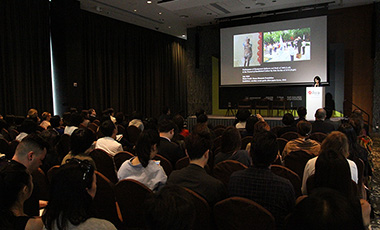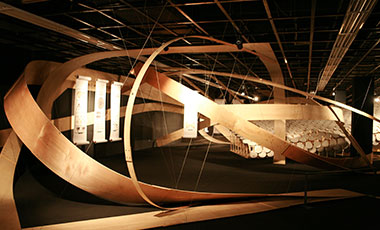Features / Report
KIAF ART SEOUL 2019 Gathers 82,000 Visitors Including BTS Members and the First Lady
posted 15 Oct 2019
130 percent increase in turnout, KRW 31 billion in sales. Event ends in success on September 29
"Galleries ecstatic about daily rush of visitors” “An event to overtake Art Basel Hong Kong"

Visitors stand in line at the entrance of the KIAF ART SEOUL 2019 held at COEX in the afternoon of Sep. 29, 2019. ⓒKIAF Art SEOUL.
It was unexpected. The 18th Korea International Art Fair (KIAF), which opened at the height of the
political controversy surrounding the newly appointed minister of justice Cho Kuk, was a raging success, despite concerns. The venue was packed throughout the event period and participating galleries were content. “Sales weren’t bad, unlike last year,” said one gallery representative. Throughout the five days including September 25, the exclusive VIP opening day, the exhibition halls bustled like it was the weekend. There was a constant stream of visitors, with more waiting in an infinitely stretched line outside the entrance.
Partaking in the KIAF for the first time this year, international gallery Lehmann Maupin (headquarters in New York) introduced works by world-renowned artists Lee Bul and Liza Lou and was stunned by the enthusiasm of the audience, reminiscent of Art Basel Hong Kong. Emma Son, senior director of Lehmann Maupin Seoul, remarked, “I was surprised to see the daily overflow of visitors. It was a gratifying experience in that I got to meet new clientele—particularly, young buyers. If such turnout continues, the event could soon catch up to the scale of Art Basel Hong Kong.”
This year’s KIAF, held at COEX in Samsung-dong, Seoul, drew to a successful close at 6 p.m. on the 29th. The Galleries Association of Korea released an official visitor count later in the evening, reporting the number to be approximately 82,000, “a 130-percent increase compared to last year’s turnout.” They also stated that sales reached KRW 31 billion.
More than ten thousand works from 175 galleries in 17 countries were sold throughout the four-day event that officially opened on the 26th. Inviting galleries from across the globe since last year, the KIAF has grown into an international event, with this year’s event rendering exceptionally fruitful. The remodeling of the COEX exhibition hall was also largely effective. With the floors newly painted and LED lights installed, the hall felt noticeably brighter and more upbeat.

The crowded scene at KIAF ART SEOUL 2019. ⓒKIAF Art SEOUL.
Many of the visitors felt that the quality of works on display was improved compared to last year’s event. Another popular review was that the event was like a battlefield, representative of the fiercely competitive contemporary art world, reaffirming of the status of Korean art. The event drew attention, not only for showcasing various works by Kim Whanki—one of which once sold at KRW 8.5 billion, the highest price among all Korean artworks ever sold at an auction—but also monochrome paintings by Park Seo-bo, Yoo Youngkuk, Yun Hyongkeun, Lee Ufan, Ha Chonghyun, and other various works by Kang Yobae, Kim Chonghak, Haegue Yang, and Lee Kunyong. Overseas galleries also flew in works by international masters like Constantin Brâncuși, James Turrell, and Paola Pivi, offering the Korean public the rare opportunity to see the works in person.

Special exhibition 《Korean Modernism, Painting, Romanticism in History》 held as part of KIAF ART SEOUL 2019 attracts an audience. ⓒKIAF Art SEOUL.
The KIAF’s very first special exhibition 《Korean Modernism, Painting, Romanticism in History》 also received a rave response. Organized by visiting professor Cho Eunjeong at Korea University, this exhibition retrospective of Korean modern art showcased 38 works by 26 artists (Kwon Okyon, Kim Kichang, Kim Eunho, Kim Whanki, No Soohyeon, To Sangbong, Park Kosuk, Park Nosoo, Park Rehyun, Park Sangok, Park Saengkwang, Park Sookeun, Park Youngseun, Byun Gwansik, Paek Youngsu, Sung Jaehyu, Oh Jiho, Lee Daiwon, Lee Manik, Lee Sangbeom, Lee Jung-seob, Yim Jiksoon, Chang Uc-chin, Chun Kyungja, Choi Youngrim, and Hwang Yongyop), demonstrating the aesthetics of Korean modern art, not to mention Korean art in general. “The exhibition was a chance to see all the expensive works by famous masters that have only been dealt in auctions,” said visitors. “The exhibition space was also unique—distinct from the crowded art fair scene.” Located in between Hall A and B dedicated to the art fair, the special exhibition zone was set up like a museum space, providing a calm and pleasant viewing experience disparate from the heated fair scene outside.

Minister of culture, sports and tourism Park Yang-woo during the opening of 18th KIAF held in the afternoon of Sep. 25. 2019. ⓒKIAF Art SEOUL.
The event also drew attention for the unprecedented visits of big-name figures and celebrities.
For the first time in over a decade, the minister of culture and tourism attended the opening of KIAF to show support. Minister Park Yang-woo visited the venue as a guest at the VIP opening on the 25th and lingered in the special exhibition zone for a substantial amount of time, showing keen interest in Korean modern art.
During the event period, members of the world-famous boyband BTS, RM and V, visited the fair, followed by Jun Jihyun, So Jiseob, Naul, and countless other celebrities who viewed and purchased artworks, attesting not only to the purchasing power of the generation whose per capita income has surpassed USD 30,000 but also the elevated level of art culture in Korea.
On the morning of the 29th, the last day of the event, first lady Kim Jung-sook arrived at the scene amid cheering gallerists. The first lady shook hands with each of the gallery representatives while perusing through the exhibition and purchased two works by emerging artists.
The Galleries Association of Korea expressed “heartfelt thanks to first lady Kim for visiting the KIAF despite the state of national affairs,” saying, “Not only her visit to the fair but also her purchase of works became a huge support for the galleries and artists.”
This year’s KIAF flaunted an exquisite presentation, rousing expectations for next year’s event in advance.
Whereas there were empty seats around the lecture hall last year, the talk lounge inside Hall B was packed with people this year—many couldn’t find a seat and had listen to the lectures standing. “Public enthusiasm and love for art in Korea were impressive,” said art historian and curator Lóránd Hegyi, who joined the event on the 26th as a lecturer. “I was surprised at the KIAF’s ability to organize a cultural exchange platform that reciprocates the demand.”

A performance by Koh Sang Woo at KIAF ART SEOUL 2019. ⓒKIAF Art SEOUL.
In order to effectively engage the public, KIAF explored various communication methods this year, such as the gallery booth, the special exhibition, lecture programs, artistic performances, and a children’s program. 〈Hug〉, a performance by Koh Sang Woo held on the opening date in front of the special exhibition hall, integrated artistic objects, painting, installation, and dance to visualize the sense of loneliness, solitude, and isolation felt by contemporary people, capturing the eyes of the guests. The public-interactive performance by Mari Kim that took place in the afternoon of the 28th also ended with a big applause. The first KIAF Art Kids, prepared for young parents accompanying children, also generated a positive response.

Lehmann Maupin, the world-famous art gallery with its headquarters in New York, took part in KIAF for the first time, presenting a large-scale work by its affiliate “marble artist” Liza Lou to catch visitors’ attention.
Overseas galleries that participated in the event had positive things to say as well. “It was a pleasant event thanks to the diversified base of the collectors and their purchasing power and the international celebrities who visited,” said a gallery representative, expressing willingness to “participate again next year in the event that has risen as the new face of Asian art market.”
Domestic galleries also seem pleased with this year’s turnout. Cho Yeoung-mu, representative of Gallery Ju Young, which showcased an array of works by beloved artists such as Lee Ufan, Kim Whanki, and Yun Hyongkeun in the event, said, “The quality of the works shown in this year’s exhibition was significantly higher than last year, and there was an increased inflow of young buyers, so the sales were higher than ever.”
※ This article was originally published in Newsis on 29 SEP 2019, and reposted under authority of Newsis. (http://www.newsis.com/view/?id=NISX20190929_0000783982&cID=10701&pID=10700)
Hyunjoo Park
Journalist, [Newsis]


